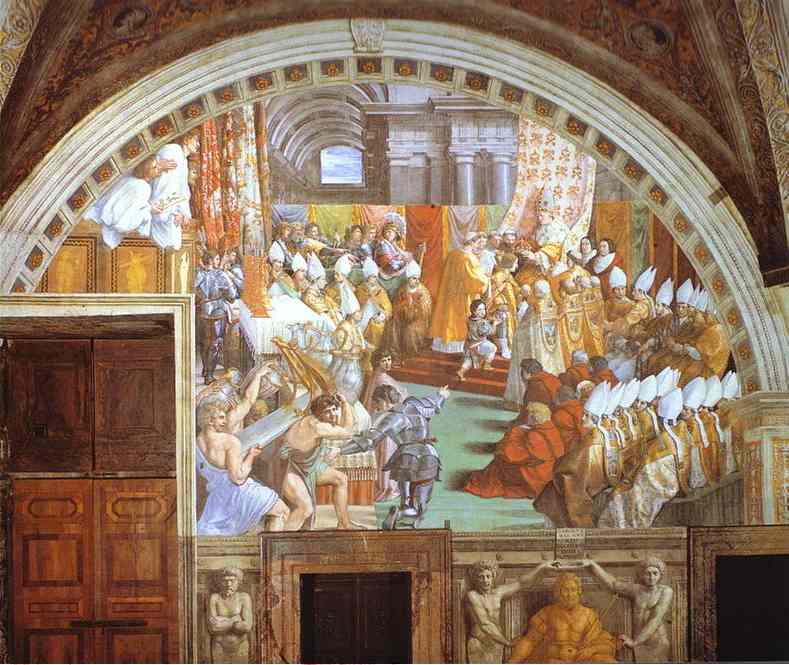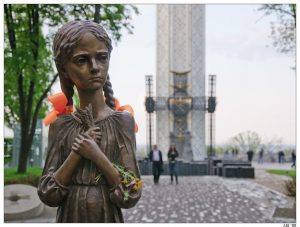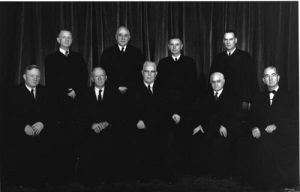There are few moments in history that compare with the crowning of Charles the Great. It was Christmas Day in the year 800 at Saint Peter’s Basilica in Rome. Charlemagne had lingered in Rome after having publicly pardoned Pope Leo III. He was attending Christmas mass. And as Charlemagne rose from his prayer, Pope Leo came up behind him with a golden crown, placed it on Charlemagne’s head, and named him Emperor and Augustus.1 Suddenly, the crowd erupted in cheers, “Long life and victory to Charles, the most pious Augustus, the great, peace-loving Emperor, crowned by God!” However, even without the grandeur of an adoring—allegedly rehearsed—crowd, Charlemagne’s coronation still would have made its mark in history.2 Crowning Charles the Great redefined the relationship between Emperors and the Church, and marked the beginning of the end of the communion between what are now known as the Eastern Orthodox Church and the Roman Catholic Church.3

By 786, Charles the Great had made a name for himself. Since the death of his brother in 771, he had taken control—militarily—over the whole western half of Europe, and managed to defeat all of his enemies and unite them under his rule. Additionally, Charlemagne’s extremely diplomatic and congenial nature helped the Frankish king create strong alliances. And if that were not enough, he ushered in a new era of educational reforms that started a period scholars call the “Carolingian Renaissance.”4
However, despite his diplomacy, in the year 787, Charles’ most important alliance was broken. Empress Irene of the Eastern capital, Constantinople, insulted Charlemagne after breaking off an engagement between their children that would have united East and West as a front against his enemies, usurped her son, and now claimed the highest authority among all rulers.5 Her actions, however, proved to be a mistake. Her coup resulted in a weakening in the Byzantine throne, and the Abbasid caliph Harun al-Rashid, the chief power of the Middle East, and the rest of the patriarch of Jerusalem, now recognized Charlemagne as the monarch that represented Christianity. Without the support of the majority of the patriarchs in the East, Charlemagne’s power grew and the West’s claim to the church exceeded that of the East.6
Still in the West, but on the other side of the spectrum, was the Papacy. Ever since 604, the papacy had been in shambles and had become an impotent position. Pope Leo III had succeeded Adrian I, and though there is still debate over this, it’s said that Adrian’s supporters were the source of all of Leo’s plights. In 798, Pope Leo was accused of venality, fornication, and perjury, and soon had an army of opposition at his back.7 Before Leo could get help, he was attacked by these supporters that tried to damage his eyes and face and his tongue to make him unsuitable for the papacy. However, he was saved, and with nowhere else to turn, looked to Charlemagne for help.8
Upon hearing Leo’s call for help, Charlemagne decided to come settle the offenses laid against him. Leo went to meet Charles at his palace northeast from Aachen, but soon discovered his enemies had beat him there. Charles, pondering what to do, sent Leo back to Rome and said that they would meet there, but at Charlemagne’s pace. It took over a year for Charlemagne to announce he was going to Rome to hear Pope Leo’s “case.” Finally, in 800, Charlemagne rode into the city in a great spectacle, and eight days later, gathered a council to have Leo “tried” for his offenses. They decided Pope Leo III would publicly make a solemn oath that the accusations against him were false, and on December 23, he did. Charlemagne had officially saved the Pope’s life. After his various demonstrations of power, and the lack of power in the East, the events that would unfold within the next two days were expected.9
Ultimately, Charlemagne’s coronation changed the course of history. This coronation set the precedent that the Papacy and the Emperor were dependent on each other and would continue to be for hundreds of years. It also began the break between the Eastern and Western churches. Easterners saw the event as a “veritable betrayal” and a clear intention of “breaking with the Empire of the East.”10 As for Charlemagne, his intentions were unclear. Many believe initially he “had such an aversion that he declared that he would not have set foot in the Church the day that they were conferred,” while others say he had representatives brought to Rome to witness the mass.11 Regardless, on December 25, 800, Charlemagne was officially declared Emperor, Augustus, and Protector of Christianity. The world would never be the same.
- Christian History and Biography, Winter 2006, s.v. “The Crowning of Charlemagne,” by Patrick Henry Reardon. ↵
- Susan Wise Bauer, The History of the Medieval World: from the Conversion of Constantine to the First Crusade (New York: W.W. Norton, 2010), 393. ↵
- Byron Hollinshead and Theodore K. Rabb, I Wish I’d Been There, Book Two: European History (New York: Anchor Books, 2009), 46. ↵
- Byron Hollinshead and Theodore K. Rabb, I Wish I’d Been There, Book Two: European History (New York: Anchor Books, 2009), 36. ↵
- Susan Wise Bauer, The History of the Medieval World: from the Conversion of Constantine to the First Crusade (New York: W.W. Norton, 2010), 390. ↵
- Byron Hollinshead and Theodore K. Rabb, I Wish I’d Been There, Book Two: European History (New York: Anchor Books, 2009), 40. ↵
- Byron Hollinshead and Theodore K. Rabb, I Wish I’d Been There, Book Two: European History (New York: Anchor Books, 2009), 38. ↵
- Columbia Electronic Encyclopedia 6th Edition, February 2013, s.v. “Saint Leo III, Pope.” ↵
- Byron Hollinshead and Theodore K. Rabb, I Wish I’d Been There, Book Two: European History (New York: Anchor Books, 2009), 42-43. ↵
- The University of Chicago Press, “After Nine Hundred Years: The Background of the Schism Between the Eastern and Western Churches,” Speculum 35, no. 1 (1960): 172. ↵
- S. E. Turner, from Einhard, the Life of Charlemagne (New York: Harper and Brothers, 1880), 56-62, 51-54, 64-66. ↵



14 comments
Elliot Avigael
Charlemagne, by far, is one of my favorite historical figures of all time. Not just for his military prowess and cunning, but his effectiveness as an administrator. It was really the first time an emperor had been crowned for the west since the fall of Rome to the Germanic tribes; and as you explained with such skill in your article, the impact of that cannot be understated.
An impressive article on a legendary man whose leadership I greatly admire. They didn’t call Charlemagne “The Father Of Europe” for no reason.
Michael Leary
Very interesting article, I had heard about Charlemagne, but, did not know really know about his life or how he ruled. Probably the most surprising thing in this article is that Charlemagne pardoned Pope Leo III and was coronated a few days later by the pope. I found it interesting how Charlemagne was called such grand titles such as protector of Christianity.
Antonio Coffee
It is strange to think about how much power Charlemagne had and how this one event would have changed Europe and the history of the world if it never happened. This coronation strengthened both the idea of the Papacy and the idea of an emperor. If this event had never happened the Papacy may have crumbled as an institution by now and there would have been more challenges to the title of emperor. It is impossible to think about what might have happened in Europe.
Diego Terrazas
It is impressive to see the extent of Charlemagne’s power. It is surprising how much of an influence he had on the church. In addition, him being the pope’s savior is an indicator of how much more powerful he is in comparison to the church. “The protector of Christianity” is a heavy title to carry and it almost makes Charlemagne seem part Divine.
Honoka Sasahara
I did not know so much about the story of Charlemagne and the separation of the two different kinds of churches. I was so glad to learn their details because I could get a few information in classes when I was a high school student in Japan. I knew how little I know about the history of the religion after reading this article.
Hector Garcia
This moment is would have definitely left its mark in history. As the coronation of Charlemagne would have been a very deep betray to the Eastern Orthodox Church. This topic seemed to be quite interesting the repercussions of this event can still be seen today. Overall, this article was well-written and seemed like there was a lot of time put into this article.
Natalia Flores
Charlemagne gets tossed around a lot in history and I’m glad to know more about him in greater depth. I didn’t know that Pope Leo III had that much trouble with supporters of the past Pope. Problems to the point that they tried to gouge out his eyes and tongue which is just brutal. It’s also interesting to hear that the reason the East (Byzantine) and the West (Charlemagne) separated because of a marriage gone wrong.
Mario Sosa
I knew that Charlemagne was one of the most important figures in the Early Middle Ages, but I did not know the extent of his influence, such as how his coronation as emperor would lead to the Roman Catholic Church and the Eastern Orthodox Church parting ways from each other. Even more astonishing was how he managed to spare the pope’s life. I found this to be a really fascinating article, excellent job!
Alexandria Martinez
I had never heard of the story of how the Roman Catholic Church and the Eastern Orthodox Church separated. It is an interesting thought that Pope Leo could have done all those things and just have been pardoned because of the decision of Charlemagne, rather than being investigated further how it would be in today’s world. I did not know that Charlemagne was the considered the Protector of Christianity but after reading this I now see why.
Robert Rees
The introduction is without question this article’s strong point. This article does well to recap a profound moment in world history. However I feel this article suffers from a small amount of inconsistency, the switching between the names Charles and Charlemagne lacks rhythm. At first I was confused as to whether or not Charles and Charlemagne were two separate people or the same person. Perhaps including Charlemagne in parentheses following Charles the Great in the introduction would have helped solve this issue.